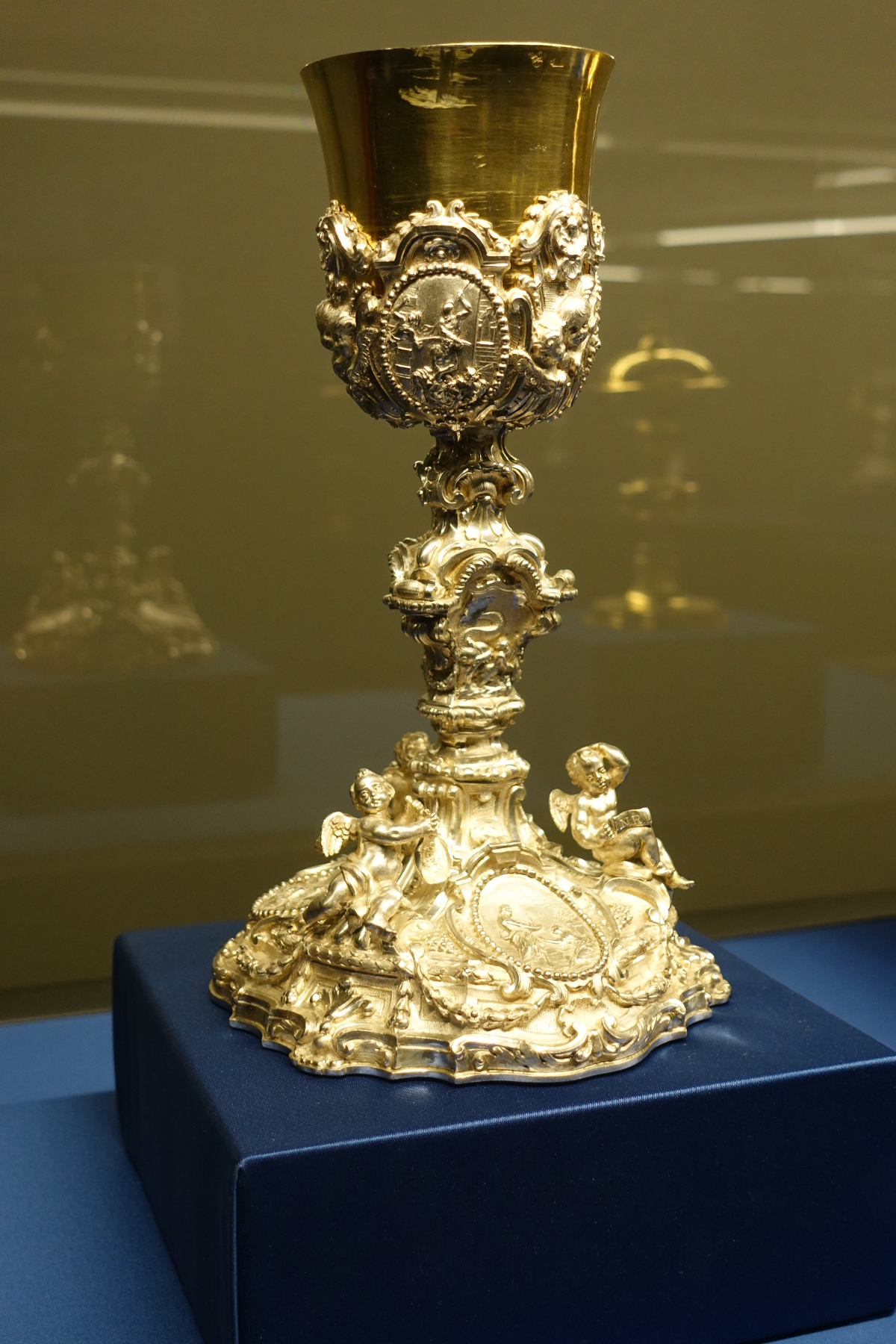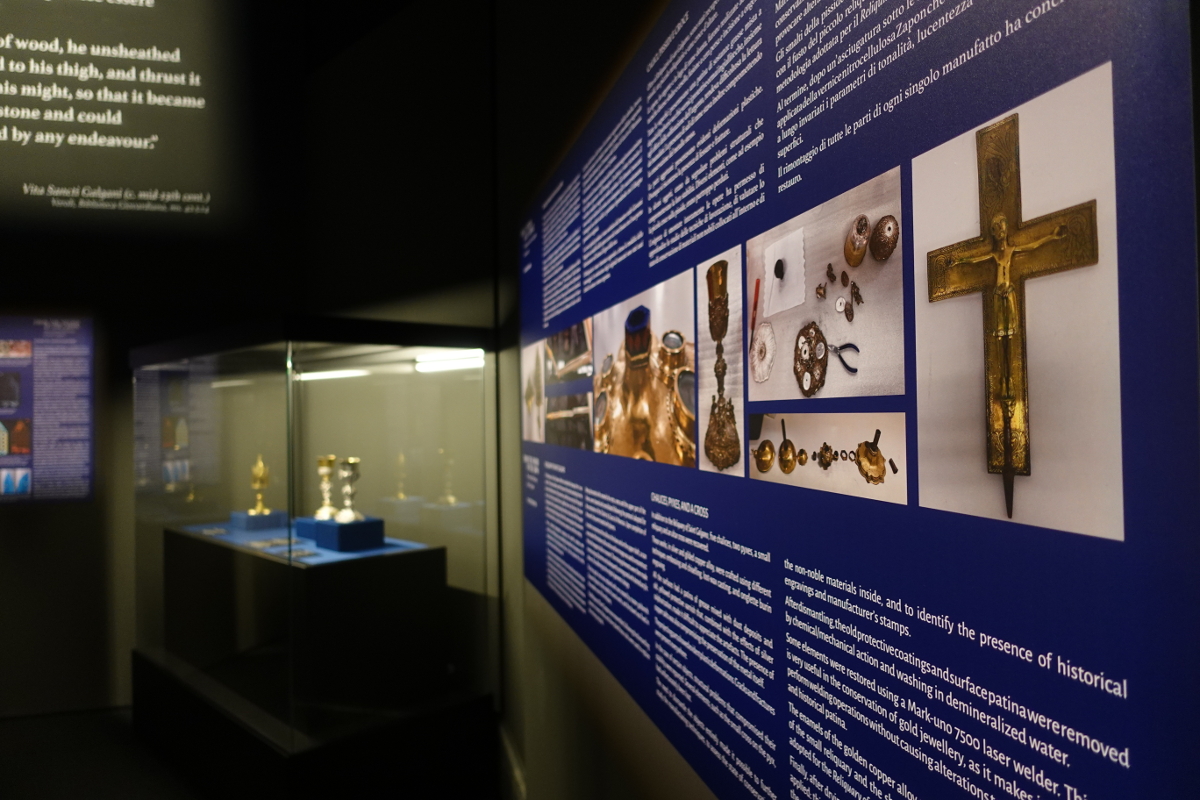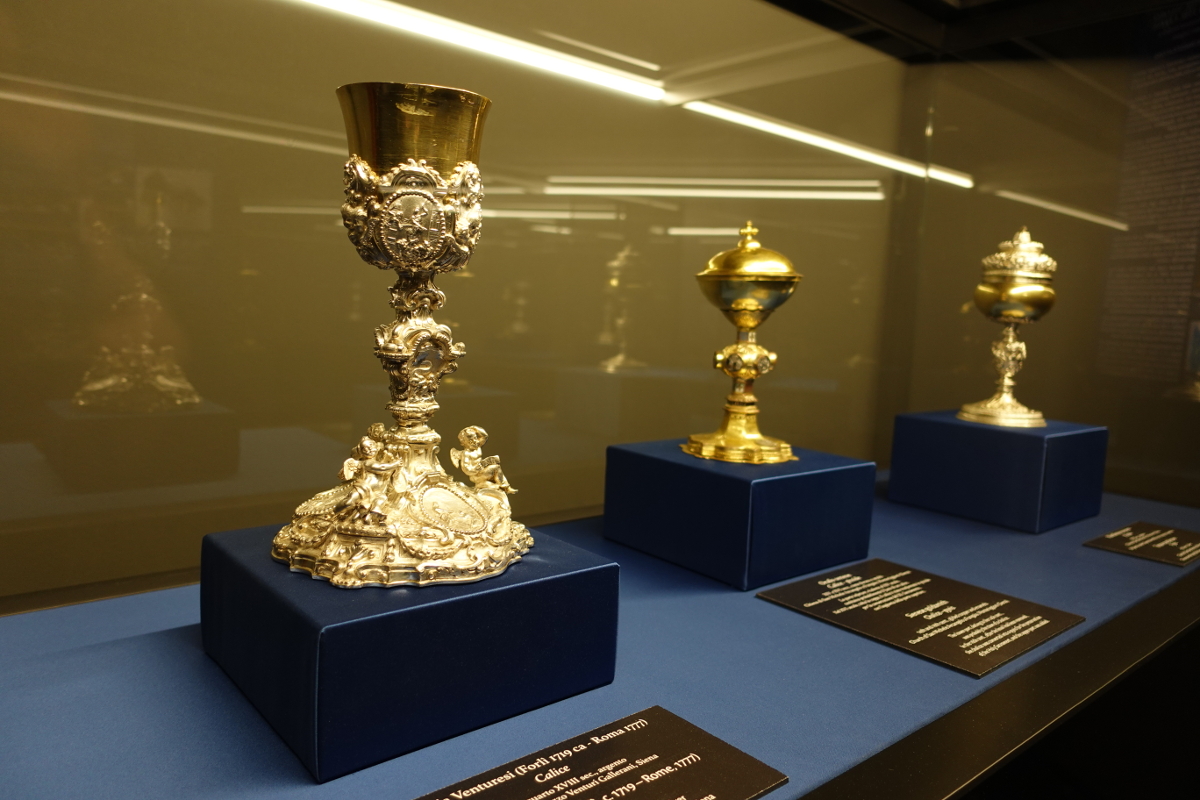From the sword to the cross. The reliquary of San Galgano restored, Preparation of the exhibition in Room XVII of the Vatican Pinacoteca | Courtesy Opera Laboratories
Unknown people robbed the museum of some precious objects created by the skilled hands of medieval and Baroque goldsmiths. The loot also included the famous Reliquary of San Galgano, from the ancient Cistercian abbey and formerly kept in the parish of Frosini, in the municipality of Chiusdino.
Thirty-one years later, on January 22, 2020, the Command of the Carabinieri, Protection of Cultural Heritage returned ten of the eleven stolen pieces to the Archdiocese, after having found them on the antiques market. The Reliquary of the saint who lived as a hermit in Tuscany in the 12th century was discovered by the Nucleus of the Carabinieri for the Protection of the Artistic Heritage of Palermo, coordinated by the lieutenant-colonel Gianluigi Marmora, inside a house in Giarre, in the province of Catania, purchased in an antiques market and remained for 31 years in the list of the 60 most precious objects sought in the world.
Now, until February 18, this extraordinary masterpiece of Sienese goldsmith production of the fourteenth century, among the most precious artifacts of the time, will be on display in Room XVII of the Pinacoteca of the Vatican Museums alongside other refined objects resulting from this extraordinary recovery, before to return to Siena.

From the sword to the cross. The restored Reliquary of San Galgano, Preparation of the exhibition in Room XVII of the Vatican Pinacoteca | Courtesy Opera Laboratories
Produced thanks to the collaboration between the Vatican Museums, the Archdiocese of Siena-Colle di Val d’Elsa-Montalcino and the Opera della Metropolitana di Siena, with the contribution of Opera Laboratori, Sillabe and Giovanni Raspini, the exhibition welcomes testimonies of refined artistic value as well as retracing one of the incredible events of “saved” art. A story featuring a processional cross, two pyxes, five chalices, as well as the Reliquary of San Galgano, an object of popular devotion with scenes from the life of the saint and his sword depicted, finely decorated in precious translucent enamels.
A seventeenth-century silver chalice from the Certosa di Maggiano in Siena, unfortunately still missing, remains out of the list of items found.
Entering room XVII of the Pinacoteca dei Musei del Papa, the public is catapulted into a triumph of silver, enamel and gilded bronze. At the center of the room is the Reliquary of San Galgano, attributed to the school of Sienese goldsmiths Tondino di Guerrino and Andrea Riguardi, with six scenes depicted from the ascetic life of the saint connected to the famous sign of the sword stuck in the rock which becomes a cross in front of which to kneel and pray. The knight belonging to the small local nobility, who converted to ascetic and hermitic life after a wild and dissolute existence, was proclaimed a saint by Pope Lucius III in 1185, just four years after his death.

From the sword to the cross. The restored Reliquary of San Galgano, Preparation of the exhibition in Room XVII of the Vatican Pinacoteca | Courtesy Opera Laboratories
An accurate intervention on the jewels present in the exhibition was carried out by the Metals and Ceramics Restoration Laboratory of the Vatican Museums and involved a campaign of scientific investigations which supported the methodological choices of the intervention. The reliquary was completely disassembled in the presence of the contact person of the Archdiocese of Siena, with the simultaneous securing of the seventy-four relics present inside. In fact, following the theft, the masterpiece suffered several damages: the shaft of the foot was fractured, the spiers deformed, while the first hexagonal spool in enamel joining the foot, which was lost, was reconstructed through a scan from a archive image. Other small missing elements were made in resin with a 3D printer.
The sides of the recto and verso, decorated with enamels, have been cleaned and consolidated, while the apical cross, also lost, was reproduced by the master goldsmith Giovanni Raspini on the model of contemporary works.
“We experimented with the use of plasma cleaning, since the shine of the enamels had been lost – explains Barbara Pinto, of the Metals and Ceramics Restoration Laboratory of the Vatican Museums -. The main problem, on the other hand, was represented by stability, given that it was not possible to make the work stand up”.

From the sword to the cross. The restored Reliquary of San Galgano, Preparation of the exhibition in Room XVII of the Vatican Pinacoteca | Courtesy Opera Laboratories
The glance, in the staging, designed and created by Opera Laboratori and Sillabe for Room XVII, is strong. On display you can also appreciate the processional cross in copper and gilded bronze, the oldest piece of the stolen goods, dating back to the 12th century, a reliquary in a small temple from the 14th century, five silver goblets made between the 17th and 18th centuries, a chalice- pyx composed of two bodies assembled in successive periods and a seventeenth-century pyx in silver.
After the Vatican Museums, the exhibition will move to the premises of the so-called Crypt of the Cathedral, where it can be visited from 1 March to 5 November 2023, in order to give back to the Sienese community and to the visitors of the cathedral a precious testimony of the cultural identity , artistic and spiritual of the city.

